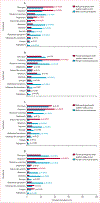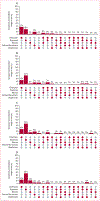Warning symptoms associated with imminent sudden cardiac arrest: a population-based case-control study with external validation
- PMID: 37640599
- PMCID: PMC10746352
- DOI: 10.1016/S2589-7500(23)00147-4
Warning symptoms associated with imminent sudden cardiac arrest: a population-based case-control study with external validation
Abstract
Background: Sudden cardiac arrest is a global public health problem with a mortality rate of more than 90%. Prearrest warning symptoms could be harnessed using digital technology to potentially improve survival outcomes. We aimed to estimate the strength of association between symptoms and imminent sudden cardiac arrest.
Methods: We conducted a case-control study of individuals with sudden cardiac arrest and participants without sudden cardiac arrest who had similar symptoms identified from two US community-based studies of patients with sudden cardiac arrest in California state, USA (discovery population; the Ventura Prediction of Sudden Death in Multi-Ethnic Communities [PRESTO] study), and Oregon state, USA (replication population; the Oregon Sudden Unexpected Death Study [SUDS]). Participant data were obtained from emergency medical services reports for people aged 18-85 years with witnessed sudden cardiac arrest (between Feb 1, 2015, and Jan 31, 2021) and an inclusion symptom. Data were also obtained from corresponding control populations without sudden cardiac arrest who were attended by emergency medical services for similar symptoms (between Jan 1 and Dec 31, 2019). We evaluated the association of symptoms with sudden cardiac arrest in the discovery population and validated our results in the replication population by use of logistic regression models.
Findings: We identified 1672 individuals with sudden cardiac arrest from the PRESTO study, of whom 411 patients (mean age 65·7 [SD 12·4] years; 125 women and 286 men) were included in the analysis for the discovery population. From a total of 76 734 calls to emergency medical services, 1171 patients (mean age 61·8 [SD 17·3] years; 643 women, 514 men, and 14 participants without data for sex) were included in the control group. Patients with sudden cardiac arrest were more likely to have dyspnoea (168 [41%] of 411 vs 262 [22%] of 1171; p<0·0001), chest pain (136 [33%] vs 296 [25%]; p=0·0022), diaphoresis (50 [12%] vs 90 [8%]; p=0·0059), and seizure-like activity (43 [11%] vs 77 [7%], p=0·011). Symptom frequencies and patterns differed significantly by sex. Among men, chest pain (odds ratio [OR] 2·2, 95% CI 1·6-3·0), dyspnoea (2·2, 1·6-3·0), and diaphoresis (1·7, 1·1-2·7) were significantly associated with sudden cardiac arrest, whereas among women, only dyspnoea was significantly associated with sudden cardiac arrest (2·9, 1·9-4·3). 427 patients with sudden cardiac arrest (mean age 62·2 [SD 13·5]; 122 women and 305 men) were included in the analysis for the replication population and 1238 patients (mean age 59·3 [16·5] years; 689 women, 548 men, and one participant missing data for sex) were included in the control group. Findings were mostly consistent in the replication population; however, notable differences included that, among men, diaphoresis was not associated with sudden cardiac arrest and chest pain was associated with sudden cardiac arrest only in the sex-stratified multivariable analysis.
Interpretation: The prevalence of warning symptoms was sex-specific and differed significantly between patients with sudden cardiac arrest and controls. Warning symptoms hold promise for prediction of imminent sudden cardiac arrest but might need to be augmented with additional features to maximise predictive power.
Funding: US National Heart Lung and Blood Institute.
Copyright © 2023 The Author(s). Published by Elsevier Ltd. This is an Open Access article under the CC BY-NC-ND 4.0 license. Published by Elsevier Ltd.. All rights reserved.
Conflict of interest statement
Declaration of interests We declare no competing interests.
Figures



Similar articles
-
Sertindole for schizophrenia.Cochrane Database Syst Rev. 2005 Jul 20;2005(3):CD001715. doi: 10.1002/14651858.CD001715.pub2. Cochrane Database Syst Rev. 2005. PMID: 16034864 Free PMC article.
-
Comparison of Two Modern Survival Prediction Tools, SORG-MLA and METSSS, in Patients With Symptomatic Long-bone Metastases Who Underwent Local Treatment With Surgery Followed by Radiotherapy and With Radiotherapy Alone.Clin Orthop Relat Res. 2024 Dec 1;482(12):2193-2208. doi: 10.1097/CORR.0000000000003185. Epub 2024 Jul 23. Clin Orthop Relat Res. 2024. PMID: 39051924
-
Continuous chest compression versus interrupted chest compression for cardiopulmonary resuscitation of non-asphyxial out-of-hospital cardiac arrest.Cochrane Database Syst Rev. 2017 Mar 27;3(3):CD010134. doi: 10.1002/14651858.CD010134.pub2. Cochrane Database Syst Rev. 2017. PMID: 28349529 Free PMC article.
-
Signs and symptoms to determine if a patient presenting in primary care or hospital outpatient settings has COVID-19.Cochrane Database Syst Rev. 2022 May 20;5(5):CD013665. doi: 10.1002/14651858.CD013665.pub3. Cochrane Database Syst Rev. 2022. PMID: 35593186 Free PMC article.
-
Behavioral interventions to reduce risk for sexual transmission of HIV among men who have sex with men.Cochrane Database Syst Rev. 2008 Jul 16;(3):CD001230. doi: 10.1002/14651858.CD001230.pub2. Cochrane Database Syst Rev. 2008. PMID: 18646068
Cited by
-
[Early classification and recognition algorithm for sudden cardiac arrest based on limited electrocardiogram data trained with a two-stages convolutional neural network].Sheng Wu Yi Xue Gong Cheng Xue Za Zhi. 2024 Aug 25;41(4):692-699. doi: 10.7507/1001-5515.202306066. Sheng Wu Yi Xue Gong Cheng Xue Za Zhi. 2024. PMID: 39218594 Free PMC article. Chinese.
-
Diagnostic value and clinical impact of cardiac magnetic resonance imaging in patients after sudden cardiac arrest: a retrospective study.Open Heart. 2025 May 14;12(1):e003090. doi: 10.1136/openhrt-2024-003090. Open Heart. 2025. PMID: 40374276 Free PMC article.
-
Prevention of Sudden Cardiac Death: Beyond Automated External Defibrillators and Implantable Cardioverter Defibrillators.Circulation. 2024 Apr 2;149(14):1059-1061. doi: 10.1161/CIRCULATIONAHA.123.066984. Epub 2024 Apr 1. Circulation. 2024. PMID: 38557124 Free PMC article. No abstract available.
-
Sudden cardiac death associated with fatty liver disease.Int J Cardiol Heart Vasc. 2025 Jan 6;56:101602. doi: 10.1016/j.ijcha.2025.101602. eCollection 2025 Feb. Int J Cardiol Heart Vasc. 2025. PMID: 39867850 Free PMC article.
-
The Singapore Physical Activity Readiness Questionnaire 2021 (SPARQ 2021)-Results of Public Feedback.Healthcare (Basel). 2025 Jul 28;13(15):1837. doi: 10.3390/healthcare13151837. Healthcare (Basel). 2025. PMID: 40805870 Free PMC article.
References
-
- Tsao CW, Aday AW, Almarzooq ZI, et al. Heart disease and stroke statistics—2022 update: a report from the American Heart Association. Circulation 2022; 145: e153–639. - PubMed
-
- Müller D, Agrawal R, Arntz HR. How sudden is sudden cardiac death? Circulation 2006; 114: 1146–50. - PubMed
-
- Nishiyama C, Iwami T, Kawamura T, et al. Prodromal symptoms of out-of-hospital cardiac arrests: a report from a large-scale population-based cohort study. Resuscitation 2013; 84: 558–63. - PubMed
Publication types
MeSH terms
Grants and funding
LinkOut - more resources
Full Text Sources
Medical
Research Materials

